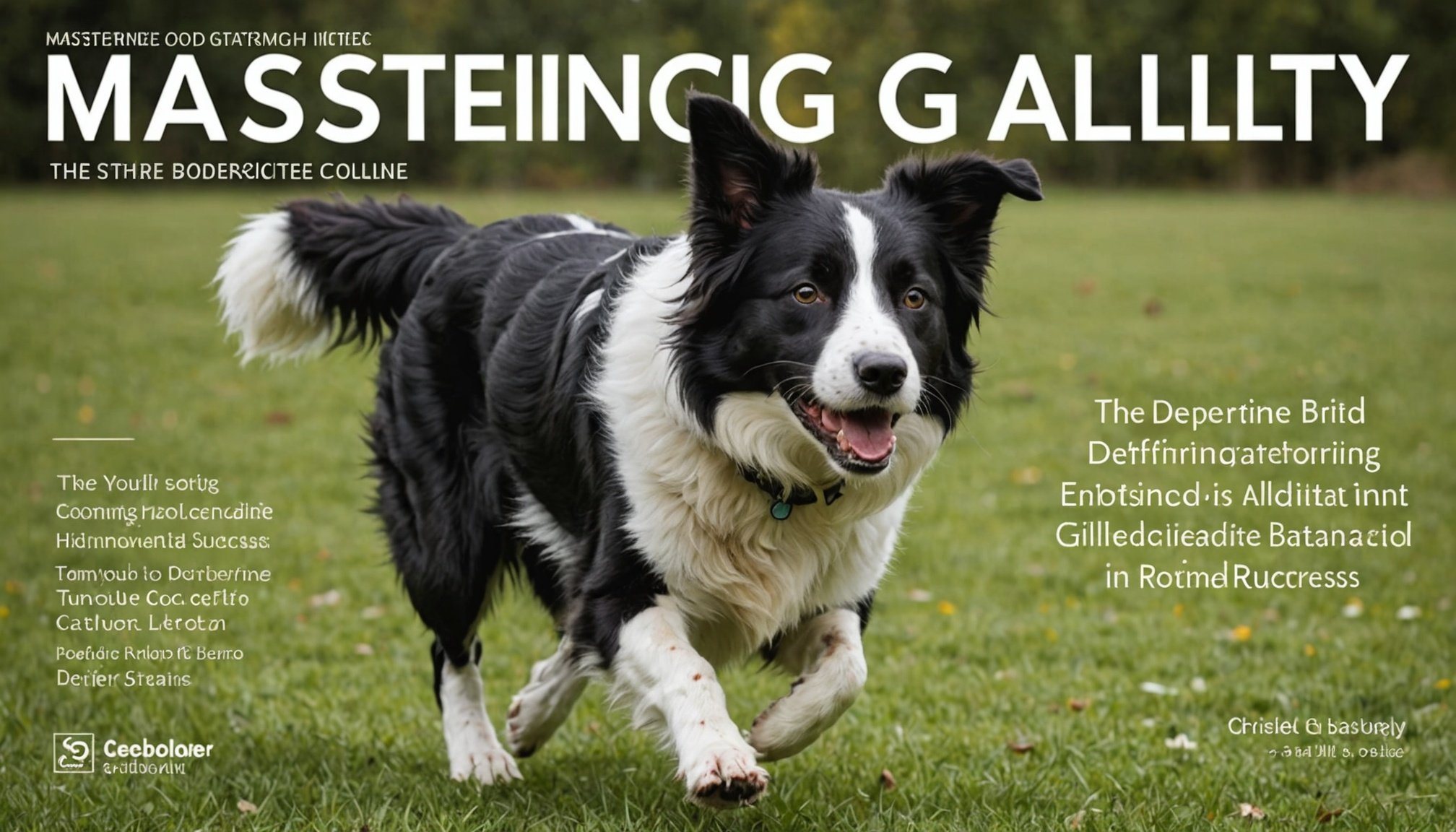Understanding the Agility Training Basics
Agility training is an essential element in a Border Collie’s life, enhancing not only physical prowess but also mental acuity. The foundational skills involved in agility training are critical for these dogs, as they provide the building blocks for more advanced tasks. Unlike general obedience training, which focuses on commands and compliance, agility training requires dynamic movement, quick thinking, and the ability to navigate obstacles swiftly and efficiently.
The foundations of agility training are pivotal because they focus on timing, coordination, and control. These ensure that the dog understands the basic movements and commands required during agility tasks. Training often involves a blend of speed, endurance, and direction-changing exercises.
Also to see : Calm Your Canine: A Fun-Filled Guide to Easing Your Dog’s Anxiety Around Loud Household Noises
Border Collies need to differentiate between agility training and typical obedience tasks. While obedience training teaches basic discipline and response to commands like sit or stay, agility training challenges a dog’s natural instincts and encourages them to react rapidly and confidently in new environments.
Understanding these agility training basics allows owners to lay a strong foundation that caters specifically to a Border Collie’s energetic nature and high intelligence. This groundwork not only keeps them engaged but also sharpens their skills for competitive events or recreational agility courses.
Also read : Paws-on-the-Go: Top Tips to Ensure Your Dog’s Comfort and Calm on Car Rides
Essential Training Techniques for Agility
Implementing effective Dog Training Techniques is vital in agility training for Border Collies. These agile dogs thrive on stimulation and structure, both of which are provided by well-planned training methods.
Positive Reinforcement Strategies
Using positive reinforcement encourages desired behaviours through rewards. Treats, praise, and toys can motivate Border Collies to perform well during agility tasks. Begin by rewarding simple actions and gradually increase complexity, ensuring the dog remains engaged and focused.
Clicker Training Method
Clicker training is a popular method, utilising a distinct sound to mark correct behaviours precisely. It helps in creating a strong link between the action and reward, reinforcing the dog’s learning process. The consistent use of clickers optimises a dog’s performance in agility exercises by building clear communication.
Shaping and Luring Techniques
Shaping and luring are techniques where desired behaviours are rewarded step-by-step. For instance, in teaching a dog to jump a hurdle, reward each progressive step towards the complete action. These techniques allow Border Collies to learn complex movements gradually, instilling confidence and precision.
Each method requires patience and consistency but offers significant benefits in developing a Border Collie’s agility skills. Adapting these strategies to meet the individual needs of your dog will ensure not only a successful, dynamic training experience but also a stronger bond between you and your pet.
Creating an Effective Training Plan
Designing a Training Plan Development for your Border Collie ensures a balanced approach to agility training. Setting realistic training goals is the first step, focusing on achievable targets that align with your dog’s current capabilities and temperament. Begin by assessing the dog’s strengths and areas that need improvement.
Establish a weekly training schedule, incorporating various exercises to keep the sessions engaging. Regular sessions, ideally two to three times a week, help dogs maintain consistency without overwhelming them. Each session can be divided into short, focused drills lasting about 20 to 30 minutes, to maximise attention spans and physical endurance.
Balance is crucial, so alongside physical agility exercises, incorporate activities that stimulate mental agility. Games that challenge problem-solving skills or training new commands help keep your Border Collie’s mind sharp.
Additionally, it’s important to remember the social aspect—interacting with other dogs and trainers fosters a positive environment. Integrate short play periods or rest sessions to prevent burnout. By structuring a well-rounded training plan with clear goals and a thoughtful schedule, you can nurture your Border Collie’s agility skills while ensuring their overall wellbeing.
Core Agility Exercises for Border Collies
Training a Border Collie for agility involves a variety of essential exercises tailored to enhance their dexterity and focus. These exercises are foundational in preparing your Collie for agility courses.
Introduction to Obstacles (Tunnels, Jumps)
Introducing your Collie to agility exercises like tunnels and jumps is crucial. Begin with simple, low-level hurdles and slowly increase the height. Tunnels should initially be short and straightforward, gradually extending and curving to present a challenge. This gradual progression reinforces confidence and reduces anxiety.
Weave Poles and Contact Equipment
Weave poles are vital for teaching agility and precision. Start with a small number of poles, rewarding your dog as they navigate through. Contact equipment like A-frames and seesaws should be introduced with caution, emphasizing safe and steady movements. Encourage your Collie to touch and interact with these with guidance and patience.
Building an Agility Course at Home
Creating an agility course at home is beneficial. Use agility exercises such as jumps or weave poles to simulate competition environments. Ensure ample space and safety precautions. Regularly monitor your dog’s progress through tracking methods like video analysis or a training journal to help refine techniques and recognize improvements.
Nutrition and Health Considerations
Understanding dog nutrition for agility is paramount for maintaining a Border Collie’s performance and wellbeing. These energetic dogs require a specialised diet to support their intense physical activities and rapid recovery.
Proper nutrition emphasises a balanced intake of high-quality proteins for muscle development, along with complex carbohydrates to provide sustained energy. Essential fatty acids are also crucial, enhancing coat health and boosting the immune system. Incorporating antioxidants and vitamins strengthens a dog’s overall health, supporting joint function and reducing inflammation.
Hydration is vital, especially during and after agility training sessions. Ensure your Border Collie has constant access to fresh water, and consider hydrating supplements to expedite recovery. Maintaining hydration not only helps prevent fatigue but also promotes efficient muscle recovery, reducing the risk of injuries.
When planning your Border Collie’s diet, focus on recommended diets formulated specifically for active dogs. Meals enriched with joint-supporting nutrients like glucosamine can be beneficial. Additionally, consult with a veterinarian to determine if dietary supplements for performance could further enhance your dog’s agility training results.
By prioritizing nutrition and health considerations, you ensure your Border Collie remains agile and healthy, ready to tackle agility courses with vigor.
Common Challenges and Their Solutions
Training a Border Collie in agility isn’t without its challenges, but addressing these proactively can enhance both performance and enjoyment.
Dealing with Distractions
Distractions can disrupt even the focused Border Collie. Begin training in a quiet area gradually introducing distractions to build tolerance. Consistent cues and rewards help redirect attention back to tasks.
Addressing Anxiety and Nerves
Anxiety and nerves in dogs can hinder agility performance. Desensitisation techniques, like gradual exposure to new environments, are crucial. Pairing new experiences with positive reinforcement can ease stress and encourage confidence.
Injury Prevention and Management
Injuries are a concern, especially in high-impact sports like agility. Ensure warm-up routines before and cooldowns after sessions. Regular vet check-ups and incorporating exercises to strengthen joints and muscles can aid in injury prevention. If injuries do occur, follow a professional’s advice for recovery, tailoring the training to avoid aggravating the issue.
Overcoming such obstacles with tailored strategies ensures a balance of safety, confidence, and enthusiasm, which is vital for success. Embrace each challenge as a learning opportunity, continuously adapting and reassessing techniques to suit your Border Collie’s evolving agility journey.
Engaging with the Community
Connecting with the Dog Agility Community is enriching for both you and your Border Collie. Engaging with other agility trainers provides invaluable support and learning opportunities. You can exchange tips and techniques, discuss agility training foundations, and share progress stories, fostering a supportive network.
Importance of Connections
Interacting with fellow enthusiasts helps maintain motivation and enthusiasm. Experience shared by experts in community forums can give you insights into refining agility exercises and overcoming challenges. You benefit from a collective knowledge pool that boosts both training effectiveness and personal growth.
Online Forums and Local Clubs
Numerous online forums and groups cater specifically to Border Collie agility enthusiasts. These platforms offer advice, tutorials, and discussions on maintaining agility training foundations. Local clubs provide a chance for face-to-face interaction. Here, your dog can socialise and participate in group training sessions, further enhancing their skills.
Participating in Competitions
Participating in agility competitions and events allows you to gauge your training’s effectiveness against your peers. It’s a wonderful opportunity to celebrate your Border Collie’s agility achievements, bringing a sense of accomplishment. Additionally, competitions can serve as a benchmark for your agility training progress, highlighting areas for improvement.











